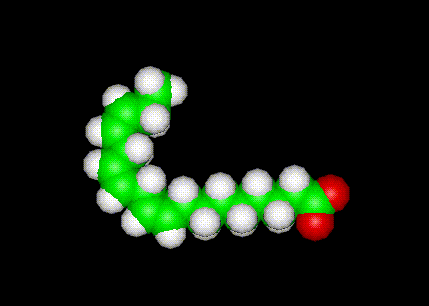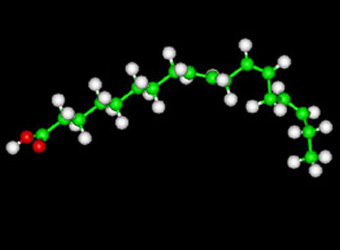Omega-3 Molecule - Health Benefits

Images are of Linolenic Acid - 18
Omega-3 fatty acids are polyunsaturated fatty acids found in certain fish tissues, and also in some vegetable foods such as flax seeds and green leaves.
Omega-3 fatty acids are classed as essential fatty acids. These fatty acids were originally designated as "Vitamin F", until it was realized that they must be classified with the fats. The essential omega-3 fatty acid that the body cannot manufacture is EPA, eicosapentaenoic acid.
The term "omega-3" signifies that the first double bond in the carbon backbone of the fatty acid, counting from the end opposite the acid group, occurs in the third carbon-carbon bond.

NOte: Below ball-and-stick image is reversed.
Common omega-3 fatty acids in the body are linolenic acid (18:3), eicosapentaenoic acid (20:5), docosahexaenoic acid (22:6).

It has been conjectured that the diet in the Human Environment of Evolutionary Adaptedness may have been rich in seafood, and that modern diets are deficient in the ratio of Omega-3 to Omega-6 fatty acids, perhaps leading to a number of modern illnesses.
Omega-3 fatty acids are important precursors of anti-inflammatory prostaglandins.
Possible benefits of omega-3 fatty acids
A number of remarkable benefits have been attributed to omega-3 fatty acids in recent years. However, these are so far provisional results, and cannot yet be regarded as fact until they have been confirmed by further studies.
- There are preliminary reports that supplementing the diet with large doses of omega-3 oils may act as a mood stabilizer, opening the possibility of their use as a treatment for bipolar disorder. However, the reports relating to this state that care must be taken to avoid overdose, and more research is needed.
- Lower doses have also been reported as having possible beneficial cardiovascular effects,.
- There are also initial reports that omega-3 fatty acids may lower the risk of dementia in old age.
Known and suspected risks of omega-3 fatty acids
In its letter entitled Letter Regarding Dietary Supplement Health Claim for Omega-3 Fatty Acids and Coronary Heart Diseasethe U. S. Food and Drug Administration Center for Food Safety and Applied Nutrition, Office of Nutritional Products, Labeling, and Dietary Supplements noted that the known or suspected risks of omega-3 fatty acids may include:
- increased bleeding times,
- the possibility of hemorrhagic stroke,
- oxidation of omega-3 fatty acids forming biologically active oxidation products,
- increased levels of low density lipoproteins (LDL) cholesterol or apoproteins associated with LDL cholesterol among diabetics and hyperlipidemics,
- reduced glycemic control among diabetics.
- suppression of immune and inflammation responses, and consequently, to decreased resistance to infections and increased susceptibility to opportunistic bacteria
In addition, another potential risk is the possibility of vitamin poisoning from taking large doses of supplements which contain Omega-3 fatty acids in addition to other dietary substances.
References
- Andrew L. Stoll et al. Omega 3 Fatty Acids in Bipolar Disorder - A Preliminary Double-blind, Placebo-Controlled Trial (http://archpsyc.ama-assn.org/issues/v56n5/abs/yoa8185.html)
- "FDA ANNOUNCES DECISION ON ANOTHER HEALTH CLAIM FOR DIETARY SUPPLEMENTS"(http://www.fda.gov/bbs/topics/ANSWERS/ANS01050.html)
- U. S. Food and Drug Administration Center for Food Safety and Applied Nutrition, Office of Nutritional Products, Labeling, and Dietary Supplements: Letter Regarding Dietary Supplement Health Claim for Omega-3 Fatty Acids and Coronary Heart Disease (Docket No. 91N-0103)
- "Seafood Gave Modern Humans Edge" (http://dsc.discovery.com/news/briefs/20010521/seafood.html)
- Omega-3 and Omega-6 Pathways (http://www.asthmaworld.org/OMEGA3.htm)
- BBC News story: Fish 'lowers dementia risk' (http://news.bbc.co.uk/1/hi/health/2356665.stm)
Pipeline Drugs
- Heart Disease
- Cancer
- Respiratory Disease
- Stroke
- Alzheimer's Disease
- Diabetes
- Pain Management
- Inflammation
- Anti-Aging Treatment
- Pipeline Medical Devices
- Investing in Pipeline Drug Companies
- Biotechnology Encyclopedia
- What are Breakthrough Therapies?
- What are Clinical Trials?